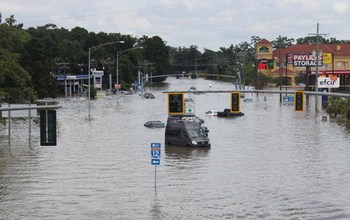By century’s end, the number of summertime storms that produce extreme downpours could increase by more than 400 percent across parts of the United States — including sections of the Gulf Coast, Atlantic Coast, and the Southwest — according to a new study funded by the National Science Foundation (NSF).
The study, by scientists at the National Center for Atmospheric Research (NCAR) and published today in the journal Nature Climate Change, also reports that the intensity of individual extreme rainfall events could increase by as much as 70 percent in some areas.
“These are huge increases,” said NCAR scientist Andreas Prein, lead author of the study. “Imagine the most intense thunderstorm you typically experience in a single season. Our study finds that, in the future, parts of the U.S. could expect to experience five of those storms in a season, each with an intensity as strong, or stronger, than current storms.”
Anjuli Bamzai, a program director in NSF’s Geosciences Directorate, added that the research has potential public safety benefits. “Extreme precipitation events affect our infrastructure through flooding, landslides and debris flows. We need to better understand how these extreme events are changing. By supporting this research, NSF is working to foster a safer environment for all of us.”
Storms and supercomputers
An increase in extreme precipitation is one of the expected effects of climate change. Scientists know that as the atmosphere warms, it can hold more water, and a wetter atmosphere can produce heavier rain. Researchers have already measured an increase in precipitation intensity across all regions of the U.S.
However, climate models are generally unable to simulate these downpours, making it difficult for researchers to assess future changes in storm frequency and intensity.
For the new study, the team used a dataset created when NCAR scientists and study co-authors Roy Rasmussen, Changhai Liu, and Kyoko Ikeda employed a Weather Research and Forecasting (WRF) model with the ability to simulate individual storms.
The simulations, which required a year to run, were performed at the NCAR-Wyoming Supercomputing Center, on a system known as Yellowstone. Prein and his co-authors used the new dataset to investigate changes in downpours over North America.
The researchers looked at how storms that happened between the years 2000 and 2013 might change if they occurred in a climate that was warmer by 5 degrees Celsius (9 degrees Fahrenheit) — the temperature increase expected by the end of the century if greenhouse gas emissions continue unabated.
Prein cautioned that this approach is a simplified way of comparing present and future climate. It does not reflect possible changes to storm tracks or to weather systems associated with climate change.
The advantage, however, is that scientists can more easily isolate the effect of additional heat and associated moisture on future storm formation.
“The ability to simulate realistic downpours is a quantum leap in climate modeling,” Prein said. “This enables us to investigate changes in hourly rainfall extremes that are related to flash flooding for the very first time. To do this took a tremendous amount of computational resources.”
Effects vary
The scientists anticipate that the number of summertime storms producing extreme precipitation will increase across the entire country, although the amount varies by region.
The Midwest, for example, could have an increase of nearly 100 percent across swaths of Nebraska, the Dakotas, Minnesota, and Iowa. But the Gulf Coast, Alabama, Louisiana, Texas, New Mexico, Arizona, and Mexico could see increases ranging from 200 percent to more than 400 percent.
The study also found that the intensity of extreme rainfall events in summer could increase across nearly the entire country, with some regions, including the Northeast and parts of the Southwest, seeing particularly large increases — in some cases more than 70 percent.
A surprising result, the scientists said, is that extreme downpours could also increase in areas that are getting drier on average, especially the Midwest.
Researchers expect the moderate rainfall events that serve as this region’s major source of moisture during summer to decrease significantly, while extreme events will likely increase in frequency and intensity. This shift from moderate to intense rainfall could increase the potential for flash floods and mudslides, and would have effects on agriculture.
“Understanding how climate change may affect the environments that produce the most intense storms is essential because of the significant impacts these kinds of storms have on society,” Prein said.
The study was also funded by the Research Partnership to Secure Energy for America.
If our reporting has informed or inspired you, please consider making a donation. Every contribution, no matter the size, empowers us to continue delivering accurate, engaging, and trustworthy science and medical news. Independent journalism requires time, effort, and resources—your support ensures we can keep uncovering the stories that matter most to you.
Join us in making knowledge accessible and impactful. Thank you for standing with us!

